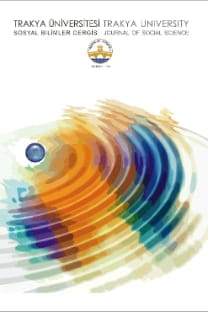İngilizceyi yabancı dil olarak öğrenmekte olan üst seviyedeki sınıflarda roman öğretimi
İngilizceyi yabancı dil olarak öğrenmekte olan üst seviyedeki sınıflarda roman öğretimi
The aim of this study is to discuss how to teach literature in EFLclasses in general and how to teach a novel in particular. First of all, I willmention about the background to the study as well as the aim and the scope.Secondly, I will touch on language competence and literary competence.Then, It will be given the importance of style. I discuss students shouldknow the style which is used by a writer to evaluate a work of art. It will bereviewed about the structure of the novel. Since the aim of this work is toshow how to study a novel, we should learn the structure of it beforeevaluating the novel. Finally, It will be explained how to teach a novel inpractice.
___
- Brumfit,C., Teaching literature Overseas: Language Based approaches, Pergamon Press,London 1983.
- Bate, J. W., Criticism: The Major Texts, Harcourt Brace Jovanovich inc, New York 1970.
- Beaugrande, R. Alain, Introduction Text Linguistics, Longman inc., London and New York, 1981.
- Brooks, Nelson, language and Language Learning, Harcourt, Brace &World inc. New York 1964.
- Brown, Gillian & G. Yule., Discourse Analysis, Cambridge University Press, Cambridge1983.
- Culler, Jonathan, Structuralist Poetics. Structuralism, Linguistics and the Study of Literature, Comell University Press, Oxford, 1975.
- Chapman, Raymond, Linguistics and Literature, Edward Arnold Ltd., U.S.A 1973.
- Corder, S. Pit, 1973, Introducing Applied Linguistics, Penguin Books, England 1973.
- Celce-Murcia, M,& L. Meintash, Rowley,(Eds,) Teaching English as a Second & Foreign Language, Newbury house Publishers, inc., Mass 1979.
- Fromkin, Victoria & R.Rodman, An Introduction to Language, USA Press, New York 1974.
- Gibaldi, Joseph & S.W., Achter, A Handbook for Writers of Researh Papers, The Modern Language Asscoiation of America Press, New York 1988.
- Hemingway, Ernest, The Sun Also Rises, USA Press, New York 1926.
- Horton, W. & Edwards, American Literary Though, USA Press, New York 1967.
- Kantarcıoğlu, Sevim,Turk ve Dünya Romanlarinda Modernism, Fon Matbaası, Ankara 1988.
- Leech, Geoffrey & M. Short, Style in Fiction, Longman Group Ltd. London 1981.
- Leech, Geoffrey, A Linguistic Guide to English Poetry, Longman Group Ltd. London 1969.
- Larsen & Freeman. 1986. Techniques and Principles in Language Teaching, Oxford University Press inc., London 1986.
- Lyons, John.1981.Language and Linguistics, Cambridge University Press, New York 1981.
- Paulstron & Bruder, Teaching English as a Second Language: Teaching Procedures, Winthrop Publishers, inc., Cambridge 1976.
- Radford, Andrew, Transformational Syntax, Cambridge University Press, Cambridge 1981.
- Stevick, Philip, The Theory of the Novel, Collier, Macmillan Ltd., New York 1967.
- Smoliski, Frank, Landmarks f American Language and Linguistics. (ed) United States Information Agency Washington, D. C. 1988.
- Wellek, Rene & and A. Warren, Theory of Literature, Harcourt Brace and World inc New York 1956.
- Watt, Ian, JJI. Rise of The Novel, Chatto and Windus, London 1967.
- Weeks, Robert P.Yayım, Twentieth Century Views, Englewood Cliffs, N.J. Prentice Hall, Inc.Hemingway, 1962.
- William,R.Mueller, Celebration .of Life Studies in Modern Fiction, Sheedland, New York, 1977.
- Yorkey, Richard C., Study Skills for Students of English,USA Press, 1982.
- Zole, Emile, “The Experimantal Novel” Literary Criticism: Wayne State University, Pope to Croce Detroit, 1962
- ISSN: 1305-7766
- Yayın Aralığı: Yılda 2 Sayı
- Başlangıç: 2000
- Yayıncı: Trakya Üniversitesi Sosyal Bilimler Enstitüsü
Sayıdaki Diğer Makaleler
İngilizceyi yabancı dil olarak öğrenmekte olan üst seviyedeki sınıflarda roman öğretimi
KARAPARA ve KARAPARANIN AKLANMASINA İLİŞKİN ULUSAL-ULUSLAR ARASI DÜZENLEMELER
MESLEK YÜKSEKOKULLARININ YEREL EKONOMİYE KATKILARI: BABAESKİ MESLEK YÜKSEKOKULU ÖRNEĞİ
PİYASA RİSKİ HESABI VE SIÇRAMALI STOKASTİK SÜREÇLER: İMKB 100 ENDEKSİNE AİT UYGULAMA
Adam Smith'in ekonomik kriz görüşü: South Sea Balonu
Engin DEMİREL, AHMET ATAKISI, Gökhan SÖNMEZLER
ORTAÖĞRETİMDE ÖĞRENCİ BAŞARISINDA AİLENİN ROLÜ
The role of families in the achievement of students at secondary education
İKTİSAT İLE COĞRAFYA BİLİMLERİNİN MEKAN KAVRAMI ÜZERİNDEN BİRLEŞMELERİ: TARİHSEL BİR YAKLAŞIM
19.-20. YÜZYIL HOLLANDA ÇİNİ VE SERAMİKLERİNDE OSMANLI ETKİLERİ
